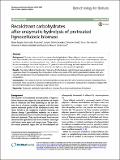Por favor, use este identificador para citar o enlazar a este item:
http://hdl.handle.net/10261/140290COMPARTIR / EXPORTAR:
 SHARE SHARE
 CORE
BASE CORE
BASE
|
|
| Visualizar otros formatos: MARC | Dublin Core | RDF | ORE | MODS | METS | DIDL | DATACITE | |

| Campo DC | Valor | Lengua/Idioma |
|---|---|---|
| dc.contributor.author | Bermúdez, María Ángeles | - |
| dc.contributor.author | Azadi, P. | - |
| dc.contributor.author | Diéz García, B. | - |
| dc.contributor.author | Molina-Heredia, Fernando P. | - |
| dc.contributor.author | Reyes-Sosa, Francisco M. | - |
| dc.contributor.author | Dobruchowska, J. | - |
| dc.date.accessioned | 2016-11-16T10:57:01Z | - |
| dc.date.available | 2016-11-16T10:57:01Z | - |
| dc.date.issued | 2016 | - |
| dc.identifier | doi: 10.1186/s13068-016-0629-4 | - |
| dc.identifier | issn: 1754-6834 | - |
| dc.identifier.citation | Biotechnology for Biofuels 9: 1- 10 (2016) | - |
| dc.identifier.uri | http://hdl.handle.net/10261/140290 | - |
| dc.description.abstract | Background: To reduce the cost of the enzymes for the hydrolysis of lignocellulosic biomass, two main strategies have been followed: one, the reduction of enzyme dosing by the use of more efficient and stable enzymatic cocktails; another, to include accessory enzymes in the cocktails to increase yields by reducing the recalcitrant carbohydrate fraction remaining at the end of the process. To guide this second strategy, we have explored the chemical bond composition of different fractions of recalcitrant carbohydrates after enzymatic hydrolysis. Results: Two lignocellulosic feedstocks of relevance for the biofuels industry have been analyzed, corn stover and sugarcane straw. On comparing the composition of chemical bonds of the starting pretreated material with samples after standard and forced hydrolysis (with enzyme overdosing), we obtained similar sugar and chemical bond composition. Conclusions: This suggests that the current enzymatic cocktails bear the set of enzymes needed to hydrolyze these feedstocks. From our point of view, the results show the need for a parallel fine-tuning of the enzymatic cocktails with the pretreatment process to maximize sugar release yield. | - |
| dc.publisher | BioMed Central | - |
| dc.relation.isversionof | Publisher's version | - |
| dc.rights | openAccess | - |
| dc.title | Recalcitrant carbohydrates after enzymatic hydrolysis of pretreated lignocellulosic biomass | - |
| dc.type | artículo | - |
| dc.identifier.doi | 10.1186/s13068-016-0629-4 | - |
| dc.date.updated | 2016-11-16T10:57:02Z | - |
| dc.description.version | Peer Reviewed | - |
| dc.language.rfc3066 | eng | - |
| dc.relation.csic | Sí | - |
| dc.identifier.pmid | 27713766 | - |
| dc.type.coar | http://purl.org/coar/resource_type/c_6501 | es_ES |
| item.openairetype | artículo | - |
| item.grantfulltext | open | - |
| item.cerifentitytype | Publications | - |
| item.openairecristype | http://purl.org/coar/resource_type/c_18cf | - |
| item.fulltext | With Fulltext | - |
| Aparece en las colecciones: | (IBVF) Artículos | |
Ficheros en este ítem:
| Fichero | Descripción | Tamaño | Formato | |
|---|---|---|---|---|
| Alcantara.pdf | 1,27 MB | Adobe PDF |  Visualizar/Abrir |
CORE Recommender
PubMed Central
Citations
2
checked on 17-abr-2024
SCOPUSTM
Citations
18
checked on 15-abr-2024
WEB OF SCIENCETM
Citations
21
checked on 27-feb-2024
Page view(s)
243
checked on 19-abr-2024
Download(s)
192
checked on 19-abr-2024
Google ScholarTM
Check
Altmetric
Altmetric
Artículos relacionados:
NOTA: Los ítems de Digital.CSIC están protegidos por copyright, con todos los derechos reservados, a menos que se indique lo contrario.
